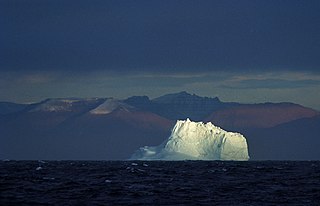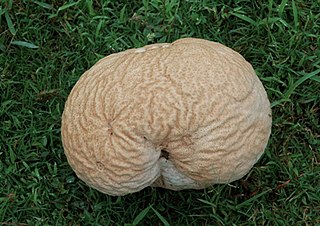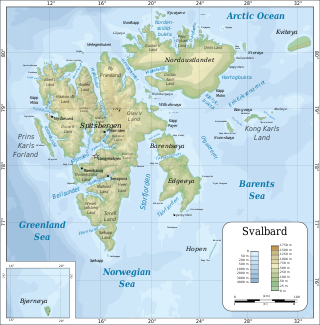Related Research Articles

The reindeer or caribou is a species of deer with circumpolar distribution, native to Arctic, subarctic, tundra, boreal, and mountainous regions of Northern Europe, Siberia, and North America. It is the only representative of the genus Rangifer. More recent studies suggest the splitting of reindeer and caribou into six distinct species over their range.

The Arctic hare is a species of hare highly adapted to living in the Arctic tundra and other icy biomes. The Arctic hare survives with shortened ears and limbs, a small nose, fat that makes up close to 20% of its body, and a thick coat of fur. It usually digs holes in the ground or under the snow to keep warm and to sleep. Arctic hares look like rabbits but have shorter ears, are taller when standing, and, unlike rabbits, can thrive in extreme cold. They can travel together with many other hares, sometimes huddling with dozens or more, but are usually found alone, sometimes taking more than one partner. The Arctic hare can run up to 60 kilometres per hour (40 mph).

Alfred Gabriel Nathorst was a Swedish Arctic explorer, geologist, and palaeobotanist.

The Greenland Sea is a body of water that borders Greenland to the west, the Svalbard archipelago to the east, Fram Strait and the Arctic Ocean to the north, and the Norwegian Sea and Iceland to the south. The Greenland Sea is often defined as part of the Arctic Ocean, sometimes as part of the Atlantic Ocean. However, definitions of the Arctic Ocean and its seas tend to be imprecise or arbitrary. In general usage the term "Arctic Ocean" would exclude the Greenland Sea. In oceanographic studies the Greenland Sea is considered part of the Nordic Seas, along with the Norwegian Sea. The Nordic Seas are the main connection between the Arctic and Atlantic oceans and, as such, could be of great significance in a possible shutdown of thermohaline circulation. In oceanography the Arctic Ocean and Nordic Seas are often referred to collectively as the "Arctic Mediterranean Sea", a marginal sea of the Atlantic.

Thymus praecox is a species of thyme. A common name is mother of thyme, but "creeping thyme" and "wild thyme" may be used where Thymus serpyllum, which also shares these names, is not found. It is native to central, southern, and western Europe.

Calvatia is a genus of puffball mushrooms that includes the spectacular giant puffball C. gigantea. It was formerly classified within the now-obsolete order Lycoperdales, which, following a restructuring of fungal taxonomy brought about by molecular phylogeny, has been split; the puffballs, Calvatia spp. are now placed in the family Agaricaceae of the order Agaricales.
The Selandian is a stage in the Paleocene. It spans the time between 61.6 and59.2 Ma. It is preceded by the Danian and followed by the Thanetian. Sometimes the Paleocene is subdivided in subepochs, in which the Selandian forms the "middle Paleocene".

The Peary caribou is a subspecies of caribou found in the High Arctic islands of Nunavut and the Northwest Territories in Canada. They are the smallest of the North American caribou, with the females weighing an average of 60 kg (130 lb) and the males 110 kg (240 lb). In length the females average 1.4 m and the males 1.7 m.
Sassenia is an extinct genus of prehistoric coelacanth lobe-finned fish that lived during the Early Triassic epoch in what is now East Greenland and Svalbard.

Boreosomus is an extinct genus of Triassic ray-finned fish. It was first described from the Arctic island of Spitsbergen, but was later also discovered in other parts of the world. The type species is Boreosomus arcticus.

Arctic tadpole shrimp Lepidurus arcticus is a species of tadpole shrimp which inhabits ephemeral pools, ponds or permanent freshwater lakes of Finland, Norway, Sweden, Svalbard, Greenland, Iceland, Russia and the Kuril Islands.
Henry Dissing was a Danish mycologist and specialist in cup fungi. He was a professor at the University of Copenhagen.

Agriculture in Svalbard – the archipelago containing the world's northernmost permanently inhabited settlements – has a short history, and remains a minor economic factor, but has nonetheless had a culturally and socially significant role, as well as an ecologic impact. Svalbard is home to the Global Seed Vault, which serves to protect the world's biological and agricultural diversity. Polar Permaculture Solutions, AS was formed in January 2015. Polar Permaculture has been focused on producing locally grown food in town, and also with composting food waste.

Bathypolypus arcticus, the North Atlantic octopus, deep sea octopus or spoonarm octopus is a small species of demersal octopus of the North Atlantic. It is usually found at depths of 200 to 600 m (660–1,970 ft) where the temperature is between 2 and 6 °C (36–43 °F).
The Arctic reindeer, properly known as the East Greenland caribou, was a subspecies of the reindeer that once lived in eastern Greenland. It has been extinct since 1900.
Dyadobacter arcticus is a Gram-negative, psychrotolerant, rod-shaped, aerobic and non-motile bacterium from the genus of Dyadobacter which has been isolated from Arctic soil from Svalbard Archipelago in Norway.
Ursidibacter maritimus is a bacterium from the genus of Ursidibacter which has been isolated from the oral cavity of a polar bear from Greenland.
Subsaxibacter arcticus is a Gram-negative, aerobic and rod-shaped bacterium from the genus of Subsaxibacter which has been isolated from intertidal sand from Kongsfjorden in Svalbard.

Teffichthys is an extinct genus of ray-finned fish from the Early Triassic epoch. Fossils have been found in Madagascar and China, and possibly also in Angola, Canada, Greenland, and Svalbard.

Ranunculus arcticus, the birdfoot buttercup, is a species of buttercup in the family Ranunculaceae. It has a circumpolar distribution in Northern Europe, Northern Asia and North America.